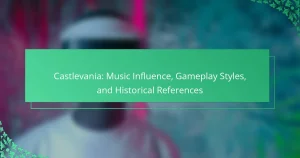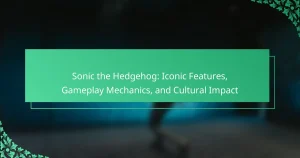The Legend of Zelda series captivates players through its innovative storytelling techniques, engaging game mechanics, and intriguing fan theories. It employs nonlinear narratives and immersive world-building to enhance player experience. Game mechanics promote exploration and problem-solving, making gameplay memorable. Additionally, fan theories explore deeper meanings and connections within the franchise, enriching community engagement.
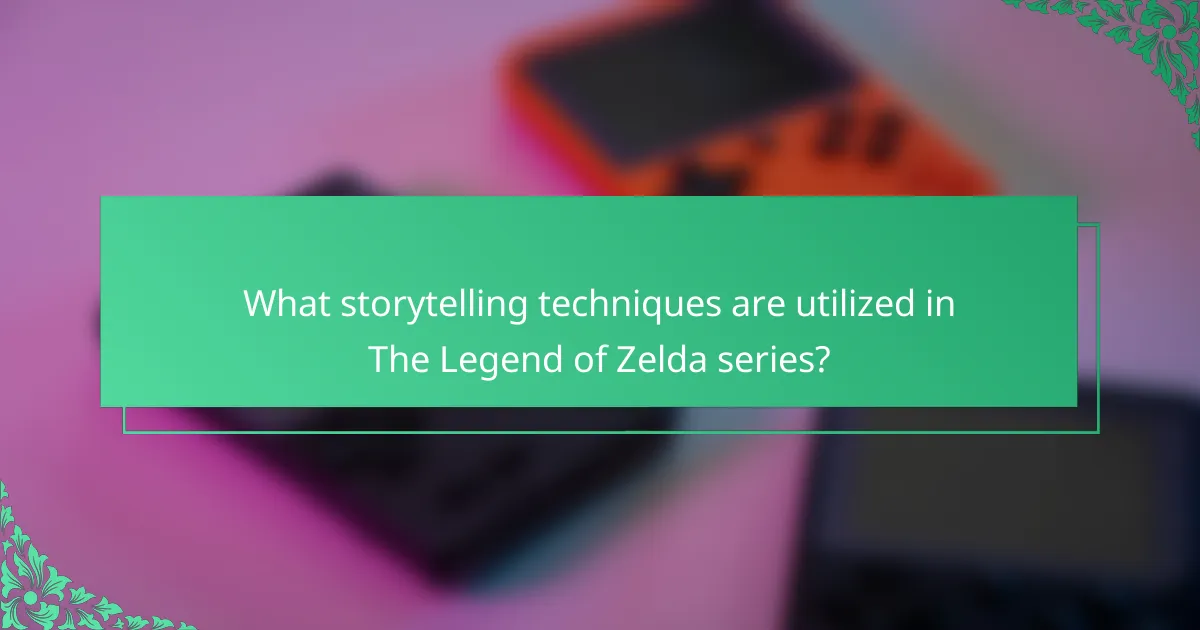
What storytelling techniques are utilized in The Legend of Zelda series?
The Legend of Zelda series employs various storytelling techniques that enhance player engagement. Key techniques include nonlinear narratives, immersive world-building, and character development. Nonlinear storytelling allows players to explore different timelines and outcomes, enriching the overall experience. Immersive world-building creates a rich lore, inviting players to discover hidden stories and connections. Character development often features relatable motivations and growth, making the journey more impactful. These elements combine to create a compelling narrative that resonates with players across generations.
How does narrative structure enhance player engagement?
Narrative structure significantly enhances player engagement by creating immersive storytelling experiences. In “The Legend of Zelda,” nonlinear narratives allow players to explore vast worlds, making choices that affect outcomes. This engagement is further amplified through character development, emotional arcs, and intricate plotlines. As a result, players feel a deeper connection to the game, fostering loyalty and ongoing interest.
Which character archetypes are prevalent throughout the games?
The Legend of Zelda features several prevalent character archetypes, including the Hero, Mentor, and Villain. The Hero, often represented by Link, embodies courage and resilience. The Mentor, typically portrayed by characters like Zelda or Impa, provides guidance and wisdom. The Villain, often Ganon, represents chaos and ambition. These archetypes drive the narrative and engage players through familiar storytelling techniques.
What role does environmental storytelling play in gameplay?
Environmental storytelling enhances gameplay by immersing players in the world and narrative of “The Legend of Zelda.” Through detailed environments, players uncover lore, character backgrounds, and quests without explicit dialogue. This technique encourages exploration and emotional connection, making the game world feel alive. Unique attributes, such as hidden items and clues integrated into the landscape, further enrich the experience. As a result, players engage more deeply with the story, fostering a sense of discovery and adventure.
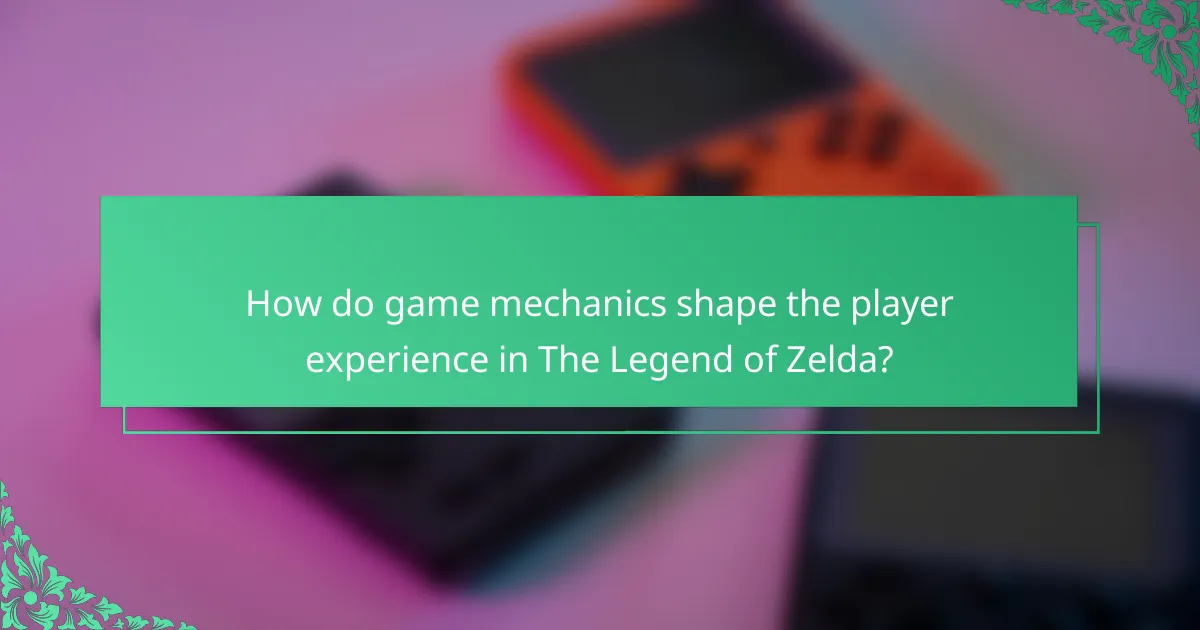
How do game mechanics shape the player experience in The Legend of Zelda?
Game mechanics significantly enhance player experience in The Legend of Zelda by promoting exploration, problem-solving, and immersion. These mechanics, such as puzzle-solving and combat systems, create engaging challenges that encourage players to interact with the game world. The unique attribute of open-world design allows players to approach challenges in various ways, fostering creativity. Additionally, the narrative integration of mechanics deepens emotional connections, making the gameplay experience memorable. The balance of difficulty and reward keeps players invested, reflecting the series’ commitment to evolving gameplay while maintaining core elements.
What are the core gameplay mechanics across different titles?
The core gameplay mechanics in “The Legend of Zelda” series include exploration, puzzle-solving, combat, and item collection. These mechanics create a rich player experience, allowing for both linear and nonlinear gameplay. Exploration encourages players to navigate diverse environments, while puzzle-solving often involves using specific items to progress. Combat mechanics vary across titles, incorporating unique weapons and abilities. Item collection enhances gameplay by providing tools that unlock new areas or abilities, reflecting the series’ emphasis on adventure and discovery.
How do puzzle-solving elements contribute to the overall experience?
Puzzle-solving elements significantly enhance the overall experience in “The Legend of Zelda” by promoting engagement and cognitive challenge. These mechanics encourage players to think critically and explore their surroundings, deepening immersion in the game’s narrative. Unique attributes of puzzles, such as their integration with the storyline, create memorable moments that resonate with players. Additionally, the satisfaction of solving these challenges often leads to a greater sense of achievement and progression within the game, reinforcing player investment.
Which combat systems are unique to specific games in the series?
The Legend of Zelda series features unique combat systems tailored to specific games. Notable examples include the “Z-targeting” mechanic in Ocarina of Time, allowing players to lock onto enemies, and the “fighting styles” in Hyrule Warriors, which offer diverse character abilities. Breath of the Wild introduced a physics-based combat system, emphasizing environmental interactions. Each system enhances gameplay and storytelling, providing distinct experiences across the franchise.

What are the most intriguing fan theories surrounding The Legend of Zelda?
The most intriguing fan theories surrounding The Legend of Zelda include the timeline theory, which proposes multiple timelines diverging from key events, and the reincarnation theory, suggesting Link and Zelda are reincarnations of past heroes. Another theory posits that the games represent different perspectives on the same story, creating a rich narrative tapestry. The connection between characters across games, such as the theory that Tingle is a reincarnation of the Great Fairy, adds depth to the lore. Lastly, the theory that the series is a metaphor for the cycle of life and death resonates with many fans, highlighting the philosophical undertones of the franchise.
Which theories connect the timelines of the games?
Theories connecting the timelines of The Legend of Zelda suggest a cyclical narrative structure. Key theories include the unified timeline theory, which posits that all games exist within a single continuum, and the split timeline theory, which divides the story into three branches following the events of Ocarina of Time. Each game explores themes of reincarnation, destiny, and the eternal conflict between Link, Zelda, and Ganon. These theories reflect the franchise’s complex storytelling techniques and fan interpretations.
How do fans interpret the symbolism in the series?
Fans interpret symbolism in “The Legend of Zelda” through its rich narrative and visual motifs. The series often employs light and darkness to represent the struggle between good and evil. For example, the Triforce symbolizes balance, with each piece reflecting wisdom, courage, and power. Fans analyze character designs, like Link’s green tunic, as symbols of heroism and adventure. Additionally, recurring themes such as sacrifice and destiny resonate deeply, allowing fans to connect personal experiences to the game’s lore. This layered storytelling invites diverse interpretations, enriching the fan experience.
What role does fan speculation play in community engagement?
Fan speculation significantly enhances community engagement by fostering discussions and deepening player investment in “The Legend of Zelda.” Players share theories about plot twists, character motives, and game mechanics, creating a collaborative environment. This speculation often leads to the emergence of unique narratives that expand the game’s lore, encouraging players to explore and connect with the franchise on a deeper level. Additionally, fan theories can influence game development, as creators may take community insights into account, reinforcing the bond between fans and the franchise.
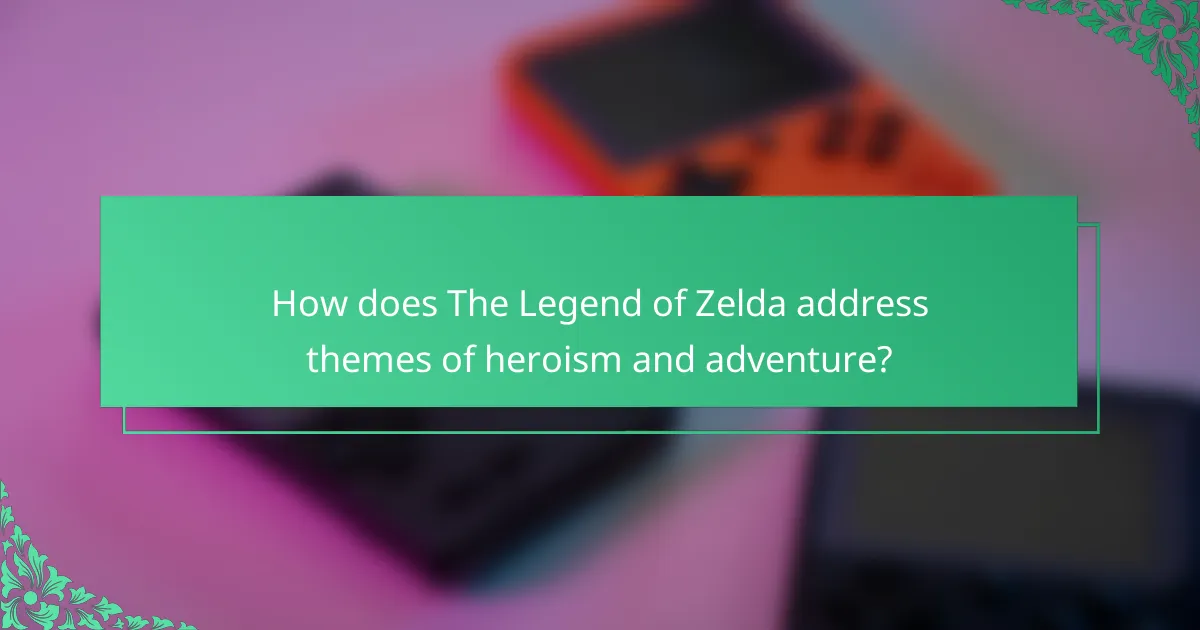
How does The Legend of Zelda address themes of heroism and adventure?
The Legend of Zelda explores heroism and adventure through immersive storytelling and gameplay mechanics. Players embody Link, a hero tasked with saving Hyrule, which emphasizes courage and self-discovery. The series incorporates quests that challenge players, reinforcing the theme of adventure. Unique elements, such as the use of puzzles and exploration, enhance the sense of discovery. Additionally, fan theories often delve into deeper meanings of heroism, suggesting that true strength lies in unity and resilience. These aspects collectively create a rich narrative that resonates with players, making heroism and adventure central to the experience.
What cultural influences shape the narrative themes?
Cultural influences such as mythology, folklore, and historical narratives shape the themes in “The Legend of Zelda.” The game draws from various cultures, including Japanese and Western traditions, integrating elements like heroism, the battle between good and evil, and quests for wisdom. For instance, the concept of the hero’s journey reflects Joseph Campbell’s monomyth, enhancing the narrative depth. Additionally, environmental storytelling and character archetypes resonate with cultural symbols, enriching player engagement and emotional connection.
How do character relationships evolve throughout the series?
Character relationships in “The Legend of Zelda” evolve through shared quests, emotional growth, and narrative depth. Link’s bond with Princess Zelda develops from protector to partner, showcasing trust and collaboration. Villains like Ganon shift from mere obstacles to complex figures with motivations, enriching the storyline. Each game introduces new characters, deepening existing relationships and creating a dynamic narrative landscape. This evolution emphasizes themes of courage, friendship, and sacrifice, making the series resonate with players across generations.
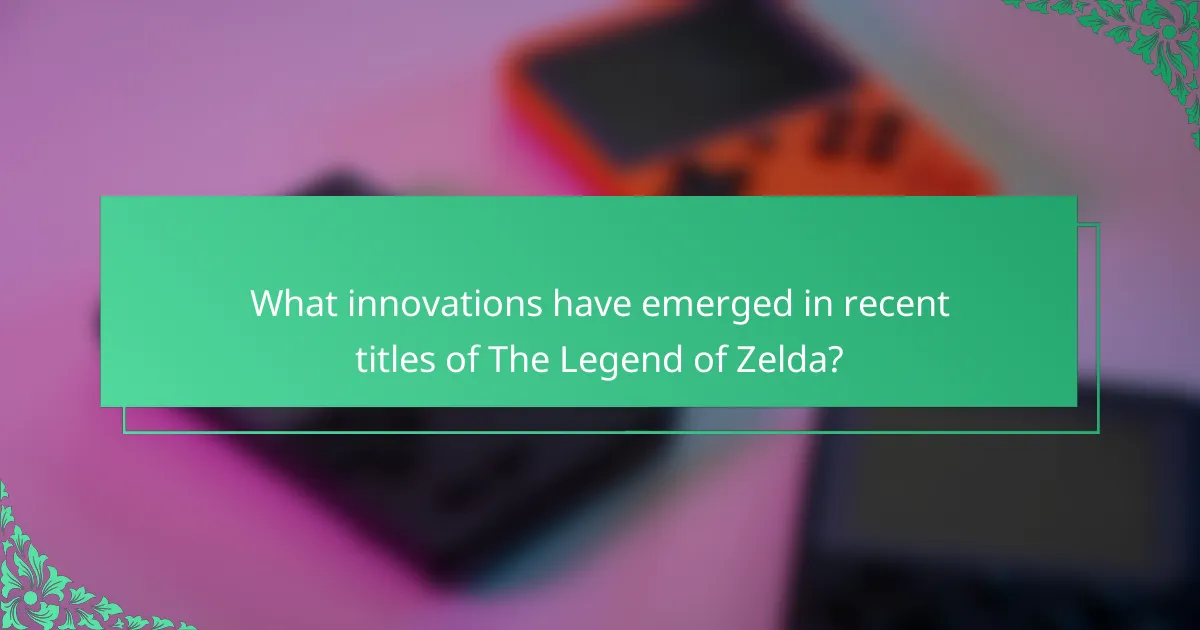
What innovations have emerged in recent titles of The Legend of Zelda?
Recent titles in The Legend of Zelda series have introduced innovative storytelling techniques, game mechanics, and fan theories that enhance player engagement. Notably, “Breath of the Wild” revolutionized open-world gameplay by allowing players to explore the vast landscape freely, a unique attribute that redefined the franchise. The narrative structure has shifted towards a more fragmented storytelling approach, encouraging players to piece together the lore through exploration and discovery. Additionally, the incorporation of physics-based mechanics has allowed for creative problem-solving, further deepening gameplay experiences. These advancements reflect the series’ commitment to evolving while honoring its roots.
How has technology influenced game design and storytelling?
Technology has profoundly transformed game design and storytelling in “The Legend of Zelda.” Enhanced graphics and sound design create immersive worlds, while advanced AI enables dynamic interactions.
Innovative mechanics, such as time travel and puzzle-solving, engage players in unique narratives. The series employs rich lore and character development, allowing for deeper emotional connections. Fan theories often explore hidden meanings and connections within the story, demonstrating the game’s lasting impact on its audience.
Moreover, technology facilitates community engagement through online platforms, where fans share theories and experiences. This interaction enriches the storytelling experience, creating a collaborative narrative exploration. Overall, technology has not only shaped gameplay but also expanded the storytelling possibilities in “The Legend of Zelda.”
Which new gameplay mechanics have been introduced in the latest releases?
The latest releases of The Legend of Zelda have introduced innovative gameplay mechanics that enhance player engagement. Notable additions include the ability to manipulate time and environment, which allows for creative problem-solving. Another significant mechanic is the integration of crafting systems, enabling players to customize weapons and tools. Additionally, the introduction of cooperative multiplayer elements fosters collaboration and shared exploration. These mechanics collectively enrich the storytelling and gameplay experience, making each adventure more immersive.
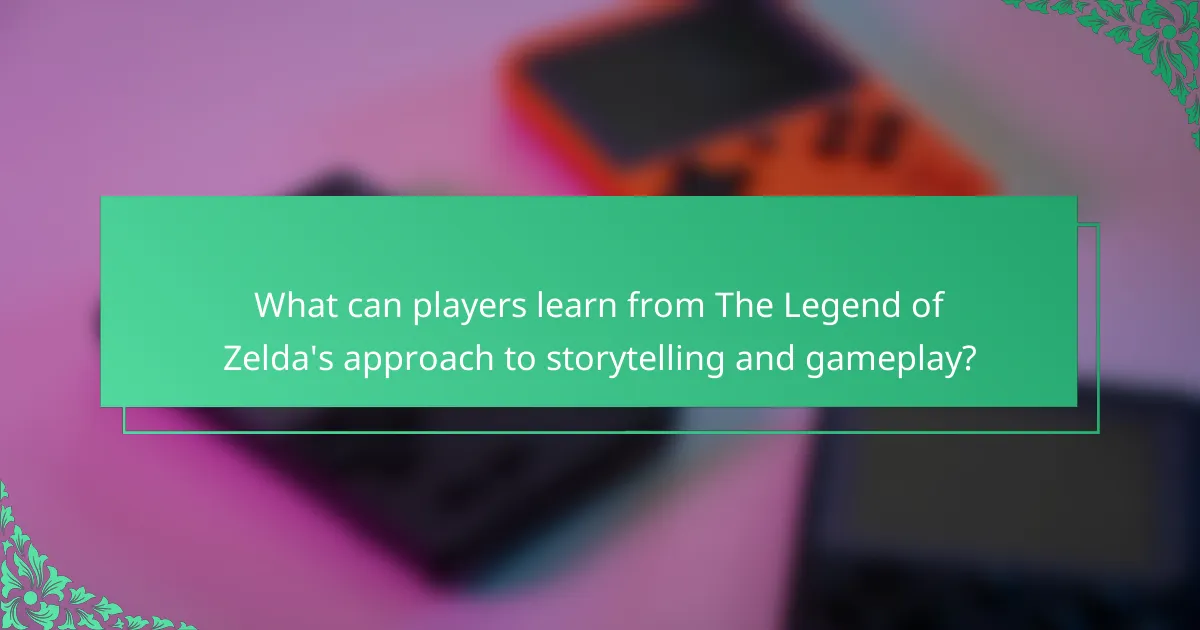
What can players learn from The Legend of Zelda’s approach to storytelling and gameplay?
Players can learn innovative storytelling and gameplay techniques from The Legend of Zelda. The series emphasizes immersive narratives, engaging world-building, and player agency.
The game employs environmental storytelling, where the landscape and design convey lore and history. This method encourages exploration and discovery, allowing players to piece together the story organically.
Game mechanics, such as puzzle-solving and item collection, enhance player engagement. These elements require critical thinking and adaptability, reinforcing the narrative through interactive experiences.
Fan theories surrounding character motivations and plot twists deepen the community’s connection to the story. These theories promote discussion and speculation, enriching the overall engagement with the franchise.
What best practices can be applied to other games inspired by the series?
Games inspired by “The Legend of Zelda” can adopt several best practices for storytelling and mechanics. First, incorporate immersive world-building that encourages exploration and discovery. Second, utilize puzzles that integrate seamlessly with the narrative, enhancing player engagement. Third, prioritize character development through meaningful interactions, allowing players to form emotional connections. Additionally, implement a balanced difficulty curve to challenge players without causing frustration. Finally, embrace community involvement by encouraging fan theories and interpretations, fostering a vibrant culture around the game.
How can understanding the narrative enhance gameplay enjoyment?
Understanding the narrative enhances gameplay enjoyment by deepening player immersion and emotional connection. In “The Legend of Zelda,” storytelling techniques intertwine with game mechanics, creating a rich experience. Players engage more fully when they comprehend character motivations and plot developments. This engagement fosters a sense of agency and investment in outcomes. Fan theories further enrich the narrative, inviting players to explore deeper meanings and connections within the game world. Ultimately, a well-crafted story elevates gameplay, making each quest more meaningful.
